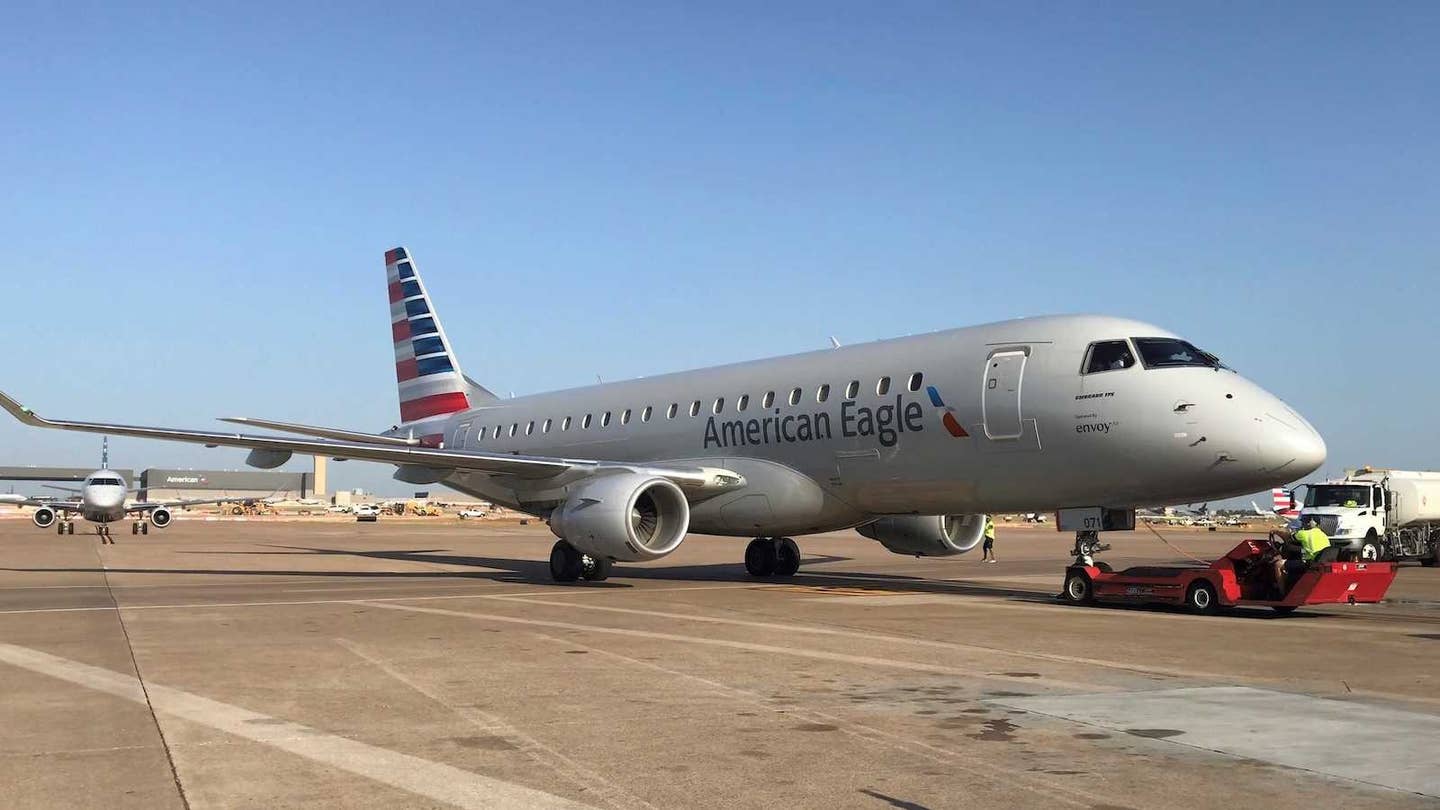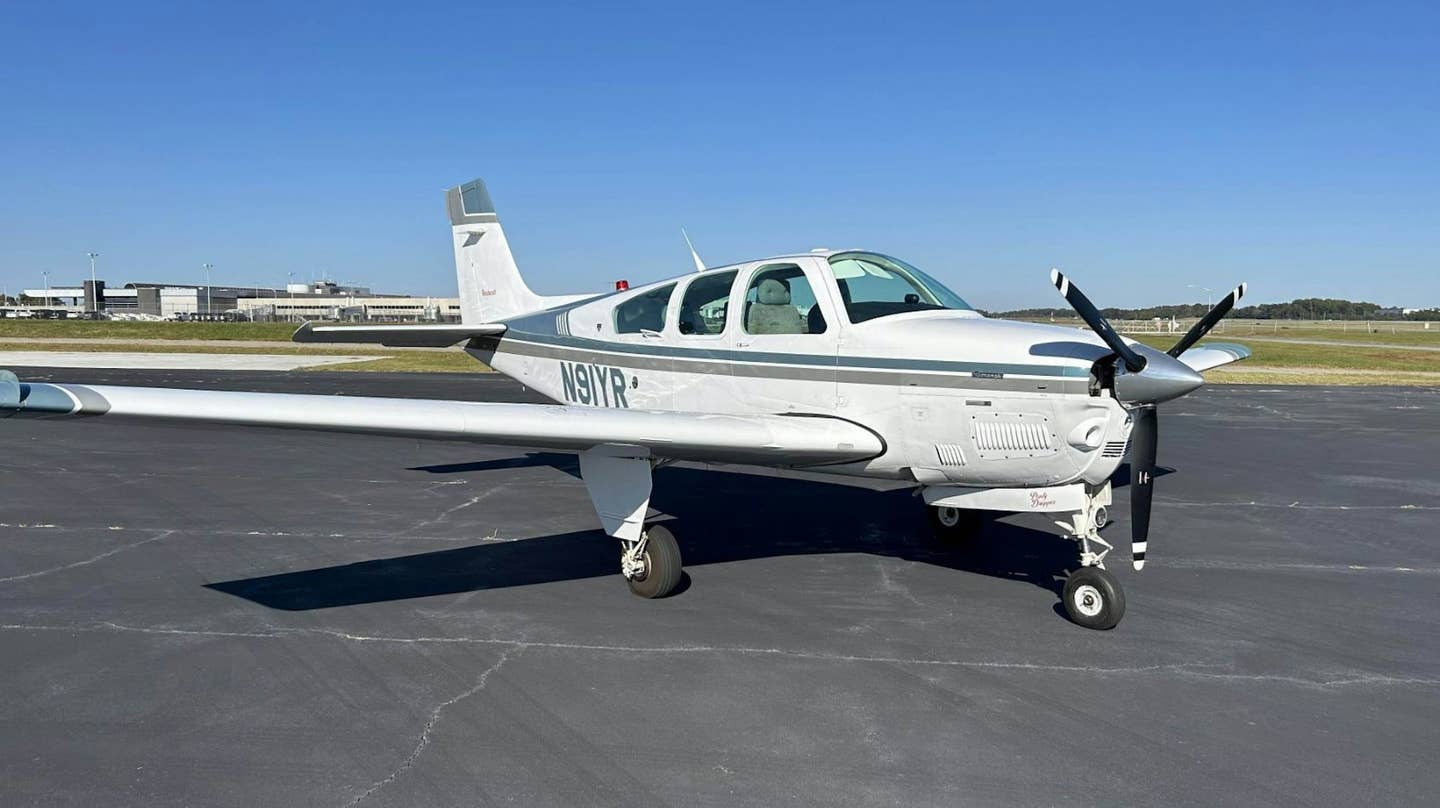
The author’s V-tail slowly being picked apart by opportunistic vultures, himself included. Ben Younger
Look at her. A double amputee fastened to a cart. My N4984M was totaled in a wind-shear incident back in May and has been sitting in a hangar in Greeley, Colorado, patiently awaiting her fate. As you can see, a decision was made. An airplane without wings is utterly helpless. It’s as if the straps are there to steady her from falling over. The interior looks no better. Holes in the panel expose a tangle of wires. Pulled up carpeting reveals raw aluminum. Seats, side panels and headliner all unceremoniously removed. Slowly she is being picked apart and parted out. It doesn’t feel very good. It’s a constant reminder of my own errors, my own shortcomings.
Whatever remains after this process will be trashed. Thankfully, there won’t be much left because aviation salvage is an efficient beast. Like deer hunting, the taking of the animal’s life can be balanced to some extent by making use of every last bit of meat. Waste of any kind makes the loss of life seem more pointless, harder to explain. So too with my Bonanza. That these parts will keep others in the air for years to come is the sole consolation of what happened in Telluride.
It’s no small task, however. In my past life I have raced and destroyed a few motorcycles. I’ve thought about parting out those race bikes, but never with much follow-through. Unlike flying, crashing a road-racing motorcycle is very much part of the deal. The bike as a whole is no longer salable, but the parts are always worth something. Once the reality of the endeavor sinks in, its charms quickly fade away. Disassembling, cleaning and taking photos of every part is just the first step. Next, you must upload everything onto eBay and decide on pricing. If you can get past all that, then you start your very own mini shipping business to get everything packed up and sent out. If you have the time, great. If you don’t, penny wise, pound foolish. Reselling used parts can be a tremendous waste of time. This is why I never bothered with my motorcycles. But the Bonanza was — is — special. Worth the effort. Our legacy fleet, after all, is on the extinction list.
I took the middle ground with 4984M by buying the salvage back from the insurance company. Then I made a deal with Jared from Beegles Aircraft Services in Greeley. There was a brief negotiation. I explained what I wanted to keep, and he made me an offer for the rest. I took the interior, avionics and a few other odds and ends from the plane. Jared will part out and sell the rest. In fact, the ruddervators sold before the ink even dried on our deal. There is a need.
Many of the parts you will find on older aircraft like mine are not replaceable with new ones. When OEM parts are available, they can be priced higher than the mythological $600 NASA hammer. Only it’s no myth. A left rudder cable for my V-tail costs $1,018 from Beech. McFarlane will sell you the same part for $254.75. An entire cottage industry exists to service pilot-owners and spare them these expenses. If finding a new part is not possible, you either find a used match or you retire the airplane. Dick Karl’s damaged Premier wing is a perfect example of how something as simple as a bird strike can end an aircraft’s life once safely on the ground.
As GA pilots, we fly legacy aircraft because we have to: It is less expensive. A new single-engine piston airplane with a glass panel can cost 10 times as much as its legacy counterpart. Interestingly, the older planes often have higher useful loads, unencumbered by modern amenities. That lower weight allows for higher speeds. A brand new A36 Bonanza cruises at 176 ktas. My 1972 V-tail does 183. This is what happens as airframes become heavier but engines do not evolve. For as advanced as the latest generation of avionics is, we are still flying behind pushrod-actuated piston engines burning leaded gas fired by magnetos — an ignition technology so old it was first used before women were allowed to vote.
But the future is burning brighter. At least the spark is. Electroair is a company that makes an electronic ignition for a number of legacy aircraft. We were all taught that two magnetos are used for redundancy. While this is partly true, what they don’t tell you is that the power the magneto produces is so weak you need two spark plugs to initiate dual flame fronts inside the cylinder to make certain the combustion event takes place in a timely fashion. The Electroair system replaces one of the magnetos while leaving the other in place to remain legal, not for any need of combustion assistance. Then there is CiES, a company that is bringing our fuel-measurement systems into the modern era with accuracy down to .075 percent of total tank volume. That’s three-tenths of a gallon in my V-tail. Both of these systems are currently finding their way into 1750W.
By combining the best of the old and the new, airplane ownership is within reach. It’s not cheap, but it needn’t be exorbitantly expensive either. With a few upgrades, you can find yourself in an airplane that flies faster and carries more than its modern-day descendant at a fraction of the price. These are exciting times.
Using my own situation as an example, here are some financial specifics. The damaged airplane was insured for $170,000. I bought it back from the insurance company for $30,000. That left me with $140,000 to replace it. I bought N1750W for $110,000, leaving me with $30,000 to purchase some additional parts and the labor of switching everything over from one V-tail to another. This is where George Aikens comes in. His company, Advanced Aerotech, sits on the field at Greeley, and it will do the job of transferring everything from one airplane to another. As the name suggests, avionics are the company’s bread and butter. It is not an interior shop by trade, but conventional wisdom suggests that if it can install a rate-based autopilot and a glass panel, then it can figure out how to attach my seats to the floor.
Along with the interior, we are reusing the Garmin GTN750 navigator as well as the remote Garmin transponder and ADS-B In/Out solution I had in the old plane. Additionally, the Whelen lights, Lord shimmy damper, G-meter, USB ports, interior LED lights, CO2 detector and even the anodized mixture/throttle/prop handles will all be pulled and given a new home in 1750W. My friend saw the list and ribbed me, asking why I wasn’t taking the dipstick. I couldn’t tell him the truth — that I simply hadn’t thought of it. Waste not, want not.
Organ donors provide an immensely helpful, often lifesaving solution for the living. But surgeons don’t typically share photos of what the donor looks like after the generous act is completed. This is probably best for all involved. I get “progress” photos from George every week. In this case, progress means seeing my former bird in various states of deconstruction. It’s useful, if painful, to see. I am reminded of the mistake I made to put her in this position. Soon, there will be no more N4984M. I have to remember those ruddervators are currently allowing another V-tail pilot in Lubbock, Texas, to pull back on the yoke and take to the air.
I loved the year and a half I spent with 4984M. We crossed the country twice, made countless burger runs, flew an instrument approach to minimums in Monterey, landed on grass strips and 9,000-foot runways, made passes over no fewer than eight friends’ homes, and once landed on a racetrack in the Arizona desert. I got stories. I will share them in time.

Sign-up for newsletters & special offers!
Get the latest FLYING stories & special offers delivered directly to your inbox






